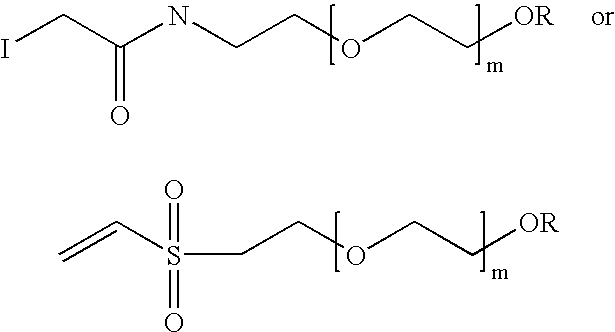Diglycosylated erythropoietin
a technology of erythropoietin and erythropoietin, which is applied in the field of new variants of erythropoietin, can solve the problems of limited bioavailability of currently available protein therapeutics such as erythropoietin and achieve maximum clinical potency, and achieve the effect of increasing the production of reticulocytes and red blood cells
- Summary
- Abstract
- Description
- Claims
- Application Information
AI Technical Summary
Benefits of technology
Problems solved by technology
Method used
Image
Examples
example 1
Production of PEGylated EPO (1-28): Synthesis of Nα-PEG-CH2—CO-(Lys(PEG-CH2—CO)20)-EPO(1-28)αCOSBzl and isolation of mono-PEGylated fractions
[0054]Peptide was synthetized by using stepwise solid-phase methods, cleaved from the resin and deprotected, purified by high performance liquid chromatography and characterized by ion-spray mass spectrometry as described in literature (see Schnolzer, M., et al., Int. J. Pept. Protein Res. 40 (1992) 180; Schnölzer, P. M., et al., G. G. Fields, ed., Solid-Phase Peptide Synthesis, Meth. Enzymol. 289 (1997), whole volume), wherein for the formation of the C-terminal benzyl thioester the route of Lu, W., et al., J. Am. Chem. Soc., 118 (1996) 8518-8523 was followed.
1.1 Synthesis of PEG-CH2—CO—NHS
[0055]mPEG-CH2—COOH—(CH3—(O—CH2—CH2)n—O—CH2—COOH) was activated with N-hydroxy-succinimide as described by Lu, Y. A., Int. J. Pept. Protein Res. 43 (1994) 127-138. Ethylenoxide repeating units were in the range of n≈110 to give a molecular weight of 5000 (PE...
example 2
PEGylation of EPO (1-28) with Bifunctional Reagents
a) Covalent Linking of Thiol Groups
[0058]This example discloses the process in determining the reaction conditions for the covalent linking of thiol groups to the fragment. To determine the conditions, different amounts of a reagent containing a blocked thiol group. In this case, SATA (succinimidyl acetylthioacetate) or SATP (succinimidyl acetylthiopropionate) (dissolved in DMSO at 10 mg / ml) was added to a solution of the fragment EPO(1-28)αCOSBzl, and then to 1 ml of 5 mg / ml fragment in 10 mM potassium phosphate, 50 mM NaCl, pH 7.3. The reaction was stirred for about 30 minutes (25° C.) and stopped by addition of 1 M lysine solution at 10 mM. Excess amounts of SATA and / or SATP were removed by dialysis against 10 mM potassium phosphate, 50 mM NaCl and 2 mM EDTA, pH 6.2. After removal of the protecting acetyl group with hydroxylamine, the number of thiol groups covalently linked to the fragment was determined photometrically with dit...
example 3
Recombinant Production of EPO (29-165)
[0060]EPO (29-165) was prepared in accordance with Example 1 of WO 99 / 05268.
Harvesting and Cell Separation:
[0061]A batch refeed process was used, i.e., when the desired cell density was reached, approx. 80% of the culture was harvested. The remaining culture was replenished with fresh culture medium and cultivated until the next harvest. One production run consists of a maximum of 10 subsequent harvests: 9 partial harvests and 1 overall harvest at the end of fermentation. Harvesting takes place every 3-4 days.
[0062]The harvest volume was transferred into a cooled vessel. The cells were removed by centrifugation or filtration and discarded. The fragment containing supernatant of the centrifugation step was in-line filtered and collected in a second cooled vessel. Each harvest was processed separately during purification.
PUM
| Property | Measurement | Unit |
|---|---|---|
| Atomic weight | aaaaa | aaaaa |
| Atomic weight | aaaaa | aaaaa |
| Atomic weight | aaaaa | aaaaa |
Abstract
Description
Claims
Application Information
 Login to View More
Login to View More - R&D
- Intellectual Property
- Life Sciences
- Materials
- Tech Scout
- Unparalleled Data Quality
- Higher Quality Content
- 60% Fewer Hallucinations
Browse by: Latest US Patents, China's latest patents, Technical Efficacy Thesaurus, Application Domain, Technology Topic, Popular Technical Reports.
© 2025 PatSnap. All rights reserved.Legal|Privacy policy|Modern Slavery Act Transparency Statement|Sitemap|About US| Contact US: help@patsnap.com

